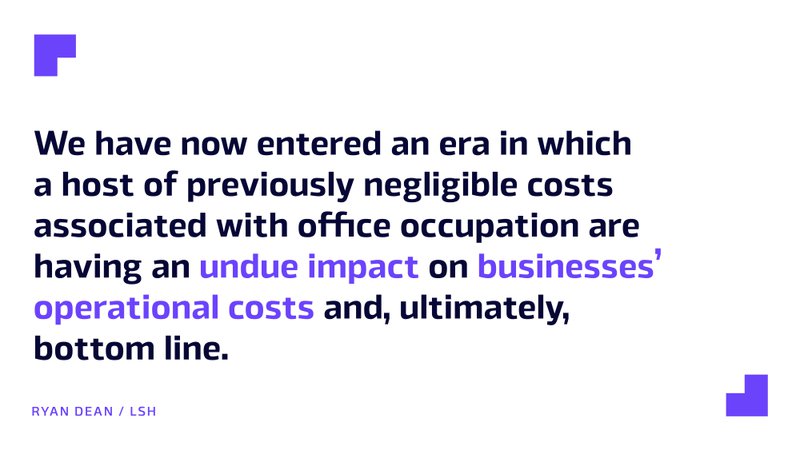In the world of commercial real estate, space management is one of the smartest routes to optimising the profitability of properties and portfolios.
The essence of space management in a commercial setting – offices, retail space, industrial units, logistics centres, or otherwise – lies in its ability to address a range of challenges.
Whether that’s reducing costs, building an environment more in step with the changing nature of work, or appealing to the shifting demands of a workforce, the process begins with understanding the nuances of how space is used.
After all, space management is not just about managing square footage – it’s about the functionality of different spaces, the flow and behaviour of occupants, visitors and employees, and the adaptability of spaces to suit various needs.
Space management can be the difference, helping real estate owners, managers and investors adapt. This is most evident in the recent rise of hybrid work models, something which necessitated a rapid reevaluation of space usage.
Managing commercial real estate spaces
Space management in commercial real estate is a discipline in and of itself, one that requires a balance of strategic planning and an understanding of occupant needs. Naturally, these things differ depending on the sector, but some of the fundamentals remain the same.
For example, a desk for every employee is no longer the default when it comes to corporate real estate and office space. Now there is a need to create flexible spaces that can accommodate fluctuating occupancy levels and diverse work styles.
As one of the smallest major commercial real estate sectors, and arguably the worst hit during the pandemic, the retail sector has suffered immensely, with lower footfall and spending, a decrease in demand, and tumbling rents. Space management can play a crucial part here, too.
With real estate often being the second-largest expense for most businesses, it’s no wonder that it comes under such scrutiny. Optimising space can lead to significant cost savings, but this optimisation isn’t merely about reducing the amount of space used – it’s about maximising the effectiveness of the available space, too.
However, for a long time, arriving at these decisions required a great deal of manual work, preparing forecasts and modelling outcomes. Nowadays though, a raft of technologies are equipping real estate owners, managers and investors with powerful insights, meaning a gut-feeling approach is no longer necessary.
The role of technology in space management
Space management technology has been a game-changer in commercial real estate. Advanced technologies are not just helping with the optimisation of physical spaces, they’re also providing insights that were previously unattainable.
This is because space management technology can reveal so much about behaviour, which paves the way for a deeper understanding of the workspace. Analysing patterns like movement, occupancy, and space utilisation gives real estate owners, managers and investors the insights they need.
The core of modern space management lies in data analytics, but before it can be analysed it needs to be collected. This is where sophisticated sensors, computer vision, and machine learning come into play, collecting and analysing the data in real-time.
Without this data-driven approach, space management is virtually impossible to get right. Decision-making is only truly effective if it is informed, and as technology gets smarter, so too do the insights.
The guiding principles of space management
Effective space management in commercial real estate is underpinned by several core ideas, with each one guiding the strategic planning and execution of space optimisation, with an intended outcome to balance efficiency, cost-effectiveness, and occupant well-being.
Let’s take a brief look at some of those guiding principles.
1. Modern workplaces demand flexibility: Spaces should be designed to adapt to various needs and changes, whether that’s to accommodate changes in team sizes, work styles, or the evolving nature of work.
2. Efficient use of space is critical. This principle involves not just minimising unused or underutilised space, but also ensuring that every square foot contributes to the organisation’s objectives.
3. A successful space management strategy places occupant needs at its core. In a corporate real estate sense, this essentially means designing spaces that support well-being, collaboration, and productivity. Retail, on the other hand, might consider visitor behaviour.
4. Incorporating sustainable practices is increasingly important. This key principle could involve a reduction in real estate footprint, which paves the way for lower carbon emissions – whether embodied or operational.
Rightsizing commercial real estate
As we’ve already seen, real estate is expensive. Facilities Management Journal has reported that the cost of occupying office space in the UK has risen to its highest level ever.
Ryan Dean, the head of transactional services at LSH, commented: “We have now entered an era in which a host of previously negligible costs associated with office occupation are having an undue impact on businesses’ operational costs and, ultimately, bottom line”.

With that in mind, it’s no surprise that occupiers are looking to optimise and rightsize as they look to minimise the associated costs of occupying corporate real estate, putting pressure on commercial real estate owners and investors.
Ultimately, the key to enhancing the value of a real estate portfolio lies in strategic assessment and management. This involves regularly evaluating the performance of the property asset, so it’s easier to make an informed decision about acquisitions, disposals, or redevelopment.
Rightsizing, on the other hand, involves adjusting space to fit current and future needs. With this, it’s all about finding the balance between too much space and not enough, both in a financial and occupant sense.
This process can often involve downsizing or restructuring, but it is rarely (if ever) achievable without the help of technology, whether that’s space management software, analytics tools or video analytics. After all, these unlock the insights that are needed to make such important decisions.
The future of space management technologies
The potential for new applications of technology in space management is vast. From computer vision to AI-driven predictive analytics to advanced simulation models, these innovations are promising deeper, richer insights into how commercial real estate is used.
While the future focus in commercial space management will likely shift towards creating more adaptive, responsive, and sustainable work environments, the central guiding principle will always remain – only through knowing a space can you optimise it.
if(window.strchfSettings === undefined) window.strchfSettings = {};
window.strchfSettings.stats = {url: “https://fyma.storychief.io/en/understanding-commercial-real-estate-space-management?id=161678356&type=26”,title: “Understanding commercial real estate space management”,siteId: “5698”,id: “afae10d0-0a44-4b0e-83bf-28c7a41365d5”};
(function(d, s, id) {
var js, sjs = d.getElementsByTagName(s)[0];
if (d.getElementById(id)) {window.strchf.update(); return;}
js = d.createElement(s); js.id = id;
js.src = “https://d37oebn0w9ir6a.cloudfront.net/scripts/v0/strchf.js”;
js.async = true;
sjs.parentNode.insertBefore(js, sjs);
}(document, ‘script’, ‘storychief-jssdk’))
